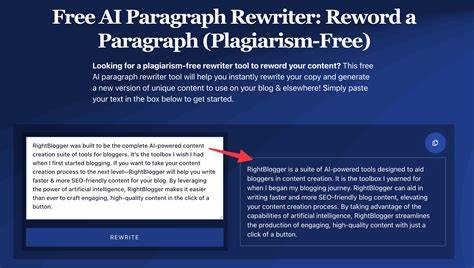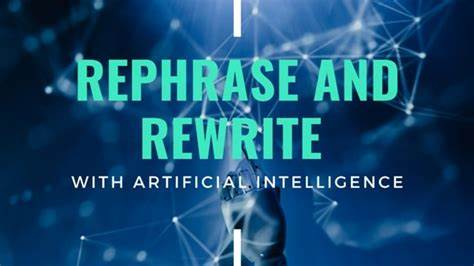
In an age dominated by digital content, the need for efficient and quality writing is paramount. Enter the “paragraph rewriter generator,” a groundbreaking tool powered by Artificial Intelligence (AI) that’s revolutionizing how we create and edit written content. This article delves into the world of AI-driven paragraph rewriting, exploring its benefits, applications, and the future it holds.

Understanding Paragraph Rewriter Generators
A paragraph rewriter generator is more than just a simple editing tool; it’s an advanced AI application that rephrases and enhances written content while maintaining the original meaning. By leveraging natural language processing and machine learning, these generators are transforming rough drafts into polished pieces of writing.

Benefits of Using AI for Paragraph Rewriting
- Time Efficiency: AI-driven rewriters save significant time in content editing, allowing writers to focus on creative aspects.
- Improved Quality: They ensure grammatical accuracy and a high standard of language.
- Customization: These tools can adapt to various writing styles, making them suitable for diverse content needs.
Common Applications
Paragraph rewriter generators are versatile. They’re used in content creation for digital marketing, academic writing, business communications, and more. These tools are also essential for SEO optimization, ensuring content is not only engaging but also search engine friendly.
Challenges and Limitations
Despite their advantages, these generators have limitations. They sometimes struggle with context and nuances, raising concerns about originality. Thus, while they’re powerful, human oversight remains crucial.
Comparing Popular Paragraph Rewriter Tools
Several tools stand out in the market, each with unique features. Some offer higher accuracy, while others are praised for user-friendly interfaces. A comparative analysis can help users choose the right tool for their specific needs.
Future Trends in AI-Based Writing Tools
The future of paragraph rewriter generators is promising. With advancements in AI, we can expect these tools to become more sophisticated, further blurring the line between human and machine-written content. This progress, however, raises important questions about the integrity of AI-assisted writing.
Conclusion
Paragraph rewriter generators with AI are more than just a trend; they are reshaping the landscape of content creation. As these tools evolve, they promise to enhance efficiency and creativity in writing, making quality content more accessible to everyone.
References and Further Reading
In addition to the insights provided in this article, those interested in exploring the capabilities and features of specific paragraph rewriter generators can delve into the following resources:
- Quillbot Paraphraser
- Resource 1: A comprehensive review of Quillbot, discussing its AI-powered paraphrasing capabilities, ease of use, and unique features.
- Resource 2: User testimonials and case studies highlighting how Quillbot has been effectively used in academic and professional settings.
- Resource 3: A technical deep dive into the AI algorithms and natural language processing techniques employed by Quillbot.
- LanguageTool
- Resource 1: An overview of LanguageTool, emphasizing its grammar checking and rewriting functions, along with its multilingual support.
- Resource 2: Comparative analyses between LanguageTool and other grammar checking tools, focusing on accuracy and usability.
- Resource 3: Tutorials and guides on how to integrate LanguageTool into various writing platforms and workflows.
- Paraphraser IO
- Resource 1: A detailed review of Paraphraser IO’s features, particularly its paraphrasing effectiveness and text enhancement tools.
- Resource 2: Case studies or user experiences demonstrating the impact of Paraphraser IO in content creation and SEO.
- Resource 3: An exploration of the AI models powering Paraphraser IO, along with updates on recent advancements and updates.
These resources offer a deeper understanding of the tools mentioned, allowing readers to make informed decisions based on their specific needs in content writing and editing.
